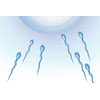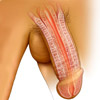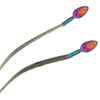- Introduction
- Appearance and location
- Structure and function of the testes
- Development of the testes in the male foetus
Introduction
The testes (testicles) are the male gonads, that is; they are the primary male reproductive organs. They fulfil two key functions, the production of gametes (sperm) and the secretion of hormones, particularly the male hormone testosterone. Other structures in the male reproductive system, including the male duct system and penis are termed accessory reproductive organs, because rather than producing gametes, they play an accessory role in the reproductive cycle, by transporting sperm out of the testes.
 |
For more information on the male duct system, see Sperm Transport Vessels. |
 |
For more information on the penis, see Penis. |
 |
For more information on sperm, see Sperm. |
Appearance and location
The testes are firm, mobile organs. A typical man has two testes approximately 5 cm long, 3 cm wide and 2.5 cm thick. Weighing 10–15 g each, the testes are suspended outside the body in a fleshy sac called the scrotum. The scrotum attaches to the body between the base of the penis and anus. The left testis lies slightly lower than the right.
Structure and function of the testes
The testes consist of a series of tubules containing testosterone and sperm-producing cells, which are covered by a multi-layered tunica. The primary function of the testes is sperm production and the main components of the testes which play a role in sperm production are the seminiferous tubules, Sertoli and Leydig cells. There are also a series of ducts and tissues within the testis which play an accessory role in producing and/or transporting sperm from the testes.
Tunica
The multi-layered tunica covers the testes, It facilitate blood supply to the testes and creates a partition between sperm producing regions of the testes. There are three layers to the tunica, the tunica vasculosa, tunica albuginea and tunica vaginalis.
Tunica vasculosa
The tunica vasculosa is the inner layer of the tunica and consists of blood vessels and connective tissue. It is covered by the tunica albuginea and facilitates blood supply to the testes.
Tunica albuginea
Tunica albuginea (Latin for white coat) is a dense layer of tissue which encases the testes and connects to the layers of fibres which surround the epididymis, the first in a series of ducts which transport sperm out of the testes and into the penis.
The tunica albuginea also extends into the testis, creating partitions between seminiferous tubules where sperm is produced. It has a bluish-white appearance and covers most of the inner layer of the tunica, the tunica vasculosa. Overlying this structure is the outer layer of the tunica, the tunica vaginalis.
Tunica vaginalis
There are two layers of the tunica vaginalis: the visceral and the parietal. The visceral layer overlies the tunica albuginea (middle layer of the tunica) while the parietal layer lines the scrotal cavity. A thin fluid layer separates the two sections of the tunica vaginalis and reduces friction between the testes and the scrotum. An increased quantity of fluid between these layers can form a hydrocoele(an accumulation of fluid).
Seminiferous tubules
Seminiferous tubules lie within the testes and are separated by partitions, which are extensions of the tunica albuginea, the middle layers of the testes’ covering. They house germ cells (23 chromosome cells which in men replicate to produce sperm) and are the site of spermatogenesis (sperm production).
Partitions divide the testes into lobules which contain the seminiferous tubules. Each lobule contains 1–4 seminiferous tubules and each testis may contain up to 900 of these tubules. The tubules average 50 cm in length and are tightly coiled within the testis. A typical testis contains up to 800 m of tightly coiled seminiferous tubules.
 |
For more information, see Spermatogenesis. |
Mediastinum
The mediastinum is a region of tissue which connects to the rete testis. The mediastinum supports the blood vessels and lymphatic system (the system which removes excess fluid from body tissues) of the testis and the ducts within the testis which transport sperm.
Straight tubules
Straight tubules connect seminiferous tubules to the rete testis facilitating sperm transport. They cross from within partitions which separate seminiferous tubules inside the testes.
Rete testis
The seminiferous tubules open into a series of channels called the rete testis.The rete testis facilitate the transport of sperm from the testes to the sperm transport ducts of the penis.
Efferent ducts
Efferent ducts are located between the rete testes and the epididymis. They connect the testes to the male ducts and facilitate the transport of sperm from the testes.
Leydig cells (interstitial cells)
In the adult male, the soft connective tissues surrounding the seminiferous tubules contain interstitial cells of Leydig. These cells are almost non-existent prior to the commencement of testicular testosterone production at the onset of puberty.
The primary function of the Leydig cells is production and secretion of androgens particularly testosterone which is the key male hormone. The primary function of testosterone produced in the Leydig cells is to stimulate spermatogenesis (sperm production) and support the development of immature spermatozoa (sperm). Some 95% of testosterone produced by the male body post-puberty is produced in the Leydig cells. Men who do not produce enough testosterone in their testicles develop a condition called hypogonadism (testosterone deficiency).
Testosterone also has a number of secondary functions related to giving the male body a typically male appearance, including:
- Regulation of central nervous system functions which influence libido and sexual behaviour;
- Stimulation of the metabolism, particularly those functions involved in protein synthesis and muscle growth;
- Maintaining glands and organs in the male reproductive system; and
- Developing and maintaining male secondary sexual characteristicswhich, compared to female characteristics include:
- Fully developed male genitals;
- Male pattern body hair distribution, that is facial hair, baldness (because testosterone decreases hair follicle growth on the top of the head) and body hair;
- Deepening of the voice;
- Muscle development;
- Increased bone density and calcium retention;
- Increased basal metabolic levels;
- Increased number of red blood cells;
- Increased body water due to increased renal reabsorption of water and electrolytes.
Sertoli cells (sustentacular cells)
Sertoli cells are also found in the seminiferous tubules; however they do not play a direct role in sperm or testosterone production. Unlike Leydig cells which proliferate at the onset of puberty, Sertoli cells are abundant pre-puberty and in the elderly. Sertoli cells have numerous important functions which facilitate spermatogenesis and sperm transport.
Their primary function in an adult is to provide support for germ cells as they grow and develop into mature spermatozoa. Stimulated by follicle stimulating hormone (FHS) which is produced in the pituitary gland and in the presence of testosterone (produced by the testes following puberty), Sertoli cells secrete proteins which bind to testosterone and other hormones in the androgen group. These androgen-binding proteins are thought to stimulate spermatogenesis by increasing the concentration of androgens in the seminiferous tubules. The Sertoli cells also secrete a nutritious protein-rich fluid into the seminiferous tubules, which sustains the germ cells and assists in their transport.
Sertoli cells further play an endocrinological (hormone-secretion) role in spermatogenesis, by producing inhibin, a peptide hormone which down-regulates pituitary FSH secretion (signals the pituitary to produce less FSH). Increases in inhibin production correlate to increases in the rate of spermatogenesis. Sertoli cells are thought to also influence the secretion of gonadotrophin releasing hormone (GnRH) from the hypothalamus (a hormone secreting gland in the brain which influences numerous reproductive functions).
Sertoli cells are linked by tight junctions and form the blood-testes barrier.
Blood-testes barrier
The blood-testes barrier functions in a similar way to the blood-brain barrier, separating the testes from the normal circulatory processes of the body (the processes through which blood and other body fluids circulate to cells in the body). The barrier prevents blood and other body fluids entering the testes; it allows only secretions from Sertoli cells (androgen-binding proteins, protein-rich fluid) to enter the lumen of the seminiferous tubules. In doing so the blood-testes barrier enables the testes to maintain a fluid balance conducive to sperm development.
The blood-testes barrier also protects developing sperm from the body’s immune system, which attacks immature sperm if the blood-testis barrier is compromised. The auto-immune response occurs because developing sperm contain sperm-specific antigens in their cell membranes, which the immune system recognises as foreign (because these antigens do not occur in other body cells) and attacks.
Development of the testes in the male foetus
A foetus develops asexual gonads until around the 6th week of gestation and male and female foetuses cannot be differentiated during this period. Genital ridges, as well as Sertoli cells, are developing in the early weeks of foetal growth. The genital ridges form the basis of the primary sex cords which will eventually develop as the seminiferous tubules of the testes in a male foetus. Germ cells reside within the genital ridges. The genital ridges form alongside the mesonephric duct, a temporary structure which connects to the reproductive organs to the kidneys in early foetal development.
At around 4 weeks gestation the genital tubercle (which will form either the glans of the penis or clitoris, depending on the sex of the foetus) begins to develop. The fold of skin which forms the anus is in place by the 6th week of gestation.
In the male foetus, the testes begin to develop from around the 7th week of gestation when cells in the core of the genital ridge of a male foetus begin secreting hormones. The hormones secreted depend on the sex of the foetus and determine whether male or female genitals develop.
Testosterone is the key male hormone and in the male foetus testosterone secretion also commences around the 7th week of gestation. This triggers the development of a male foetus. Testosterone production also influences the developing hypothalamus and programs hypothalamic functions including hormone secretion, and regulation of libido and sexual behaviour.
Sertoli cells play an important role in testicular development at this stage. They secrete Müllerian-inhibiting factor, a hormone which inhibits the growth and causes regression of female reproductive organs (also called Müllerian ducts). In the absence of testosterone and Müllerian-inhibiting factor, a foetus will develop female reproductive organs.
Around the 7th week of gestation when testosterone secretion begins, the temporary mesonephric duct disintegrates into two structures called mesonephric nephrons. In the male foetus, the mesonephric nephrons form the basis of the testes. Testicular development commences with formation of two testis cords which connect to the mesonephric nephrons. Each testis cord eventually develops into the seminiferous tubules of that testis. These tubules are encased by the testicular tunica albuginea, and are attached to the rete testis, which have developed by the 12th week of gestation. The male reproductive ducts begin to form from the 4th month of gestation.
Around the 7th week of gestation when the testis cords begin to form, a bundle of connective tissue fibres referred to as the gubernaculums testes also develops. This tissue extends from each testis to connect with the peritoneum and holds the testes in position within the abdominal cavity for most of the foetal development period.
Hormonal changes which occur around the 7th month of gestation trigger contraction of the gubernaculums testes and cause the testes to descend from the abdominal cavity to the scrotum. The testes leave the body cavity and begin existing outside it, in the scrotum. The tunica vaginalis, or outer covering of the testes, separates from the peritoneum and descends from the abdominal cavity to the scrotum in about the 7th month of gestation. Descent of the testes is essential for fertility, as the testes cannot produce sperm if they are trapped in the abdominal cavity.
The epididymis, vas deferens and seminal vesicles (male duct which transport sperm to the penis) have formed at this stage. They do not form part of the structure of the testes, but they descend with the testes into the scrotum. These ducts collectively form the spermatic cord which transports sperm to the penis.
References
- Marieb EN, Essential of Human Anatomy and Physiology. (7th edition). San Francisco: Benjamin Cummings; 2003. [Book]
- Snell RS. Clinical Anatomy for Medical Students (6th edition). Philadelphia: Lippincott Williams & Wilkins; 2000. [Book]
- Martini FH. Fundamentals of Anatomy and Physiology. 4th Ed. Sydney: Prentice Hall Inc; 2001. [Book].
- Standring S (ed). Gray’s Anatomy: The Anatomical Basis of Clinical Practice (39th edition). Edinburgh: Elsevier Churchill Livingstone; 2005. [Book]
- Guyton AC, Hall JE. Textbook of Medical Physiology (11th edition). Philadelphia: W.B. Saunders; 2006. [Book]
- Allen C, McLachlan R. Testosterone deficiency in men: diagnosis and management. Aust Family Phys. 2003;32(6):422-9. [Abstract]
All content and media on the HealthEngine Blog is created and published online for informational purposes only. It is not intended to be a substitute for professional medical advice and should not be relied on as health or personal advice. Always seek the guidance of your doctor or other qualified health professional with any questions you may have regarding your health or a medical condition. Never disregard the advice of a medical professional, or delay in seeking it because of something you have read on this Website. If you think you may have a medical emergency, call your doctor, go to the nearest hospital emergency department, or call the emergency services immediately.







